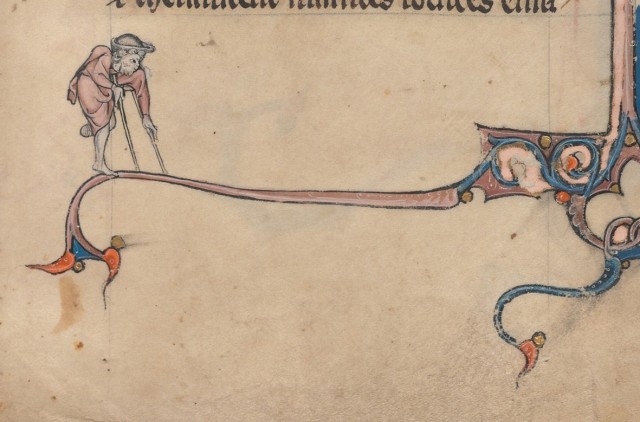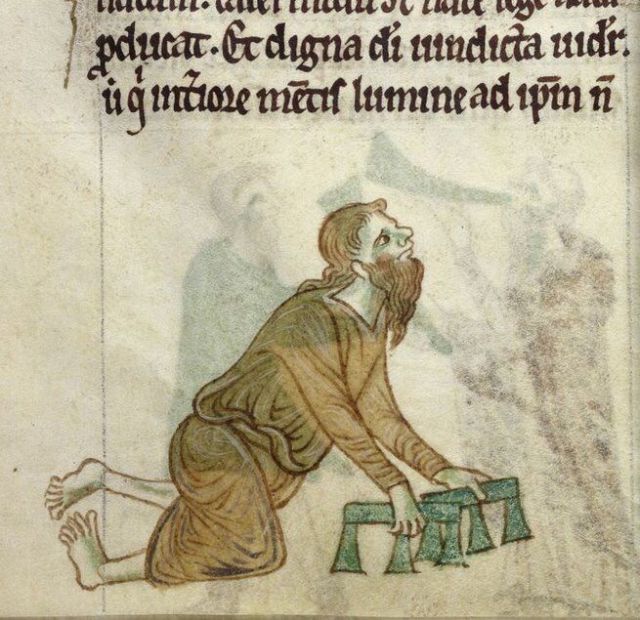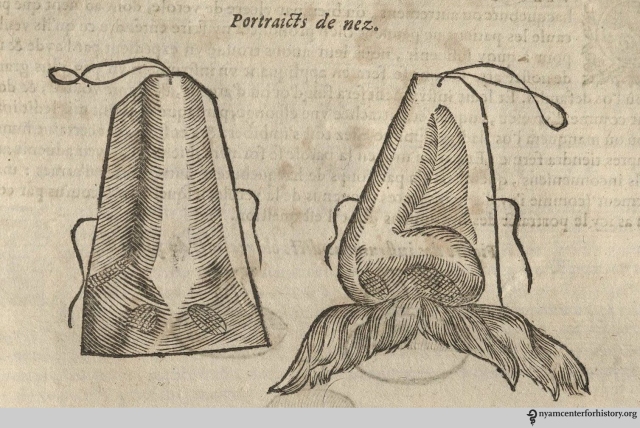Following the recent publication of a special issue of Textual Practice, “Prosthesis in Medieval and Early Modern Culture” , Katie Walter (co-editor of the special issue with Chloe Porter and Margaret Healy) talks us through the origins of the special issue and the conference that inspired it, and gives us a brief introduction into the fascinating world of prosthesis studies.
Katie is a Lecturer in Medieval English Literature at Sussex and a member of Sussex’s Centre for Early Modern and Medieval Studies.

from Beinecke MS 229, f.108r 13th c. from: http://brbl-dl.library.yale.edu/vufind/Record/3433279
When did you first become interested in the idea of prosthesis, and how did the symposium come about?
CEMMS has a strong research focus on materiality and bodies – Chloe Porter’s work on completion and incompletion in early modern drama, Margaret Healy’s on medicine, and my own on skin and flesh all intersect with notions of prosthesis. The symposium offered us an exciting opportunity to think collaboratively about it, but also to bring together and build links with scholars doing new work in this area elsewhere in the UK. Since the interest in CEMMS in materiality and the body intersects with other work going on in the School of English – Peter Boxall is working on prosthesis and the novel, for example – Sussex is generating a lot of new work in this area, and so was a good place to host a conversation about this.
Can you tell us a bit about the symposium?
There was a fascinating array of papers variously treating noses, knees, stumps, statues, words, corsets and skin! The idea of prosthesis, and bodily modification more generally, can shift our attention to and give a means of understanding the significance of body parts, as well as textual passages that are sometimes marginalised in other approaches to the body or to literature. Our symposium speakers showed that ideas of prosthesis – from the medical to the philosophical – can be really productive in opening up readings of medieval and early modern literature and culture. What was striking was that these medieval and early modern examples provoked similar questions to those raised by contemporary discourse on prosthesis, but in ways that also remained distinctive from them. In particular, as we hope the special issue shows, premodern examples disrupt some of the periodised claims about prosthesis, as well as contribute to shared understandings of it.

Man using walking aids, from Royal 13 B VIII, f. 30v (see: http://www.bl.uk/manuscripts/Viewer.aspx?ref=royal_ms_13_b_viii_f001r)
What senses of “prosthesis” does the special issue engage with?
The symposium was primarily concerned with prosthesis as a broader category of premodern practices of bodily modification – so it engaged with prosthesis principally as “the replacement of defective or absent parts of the body by artificial substitutes” (OED, s. v. “prosthesis”). As the symposium highlighted, however, instances of physical prostheses in premodern contexts always lead elsewhere, into considerations of – and, very often, into controversies over – the linguistic, figurative, rhetorical, philosophical or theological. So the special issue understands prosthesis in quite fluid terms – as historical practice and literary or theoretical tool – but all the essays are rooted in material, bodily examples. In recent literary criticism, prosthesis has been used in wide-ranging ways: for example, to think through the relationships between text and the act of criticism, between narrative and the act of reading, and between the body and the book, in ways that resist or challenge our critical fantasies of (bodily and textual) wholeness, completion, or containedness.
The Foreword of the journal mentions that critical explorations of prosthesis often focus on technological, rhetorical and philosophical conditions “understood to be unavailable to the pre-modern” – in what ways does this special issue challenge periodised assumptions?
Contemporary work on prosthesis partly has been motivated by developments that seem distinctly modern – medical, bionic and virtual technologies that allow transplants and implants, that change, enhance and extend the human body, and that challenge the boundaries between human and non-human. These developments are seen to provoke questions, states and interrelationships peculiar to contemporary experience. Another motivation for the critical interest in prosthesis arises from its linguistic and rhetorical senses, which mark its first appearance in the English lexicon in the sixteenth century. This has been taken as a transitional moment when new ideas emerge and become possible. Yet another impetus comes from twentieth-century theory and philosophy – Freud uses prosthesis to think about the interactions of mind and body, Derrida to think about the relation of speech and writing, for example. While we can bring contemporary philosophical and critical discourse on prosthesis to our readings of premodern texts, the assumption has been that premodern periods (perhaps for want of the word) don’t, or can’t, “do” the same kinds of prosthetic thinking. Essays in the special issue show the artificiality of these periodised boundaries, and allows us to rethink some of the claims – about the Reformation, about theological debate over idolatry, about transplants and implants and the limits of the self, and about the absence of premodern prosthetic thought – that have been predicated on the idea of prosthesis. Chloe’s essay, for example, highlights the ways in which, in some accounts, Reformation anxiety over idolatry has been coupled to a periodised understanding of prosthesis as other or artificial – an understanding, in turn, founded on the OED’s citations showing the earliest appearances of the word. Giving earlier evidence for the use of “prosthesis” in English, Chloe shows, however, that prosthesis has plural and nuanced connotations in this period that cannot be made simply to support standard narratives of historical change. Similarly, Isabel Davis’s piece on the Reformation re-writing of the meanings of kneeling – as mediated principally through an addition, known as the Black Rubric, to The Book of Common Prayer in 1552 – exemplifies how the concept of prosthesis itself can be used to bridge and move beyond, at the same time as it marks and exposes, cultural and historical ruptures and differences that have been attached to the early modern period.

from Les oeuvres d’Ambroise Paré (1633 edn)
You, Chloe and Margaret mention disability studies in your Foreword, and Julie Orlemanski addresses the ways in which the “subfield of medieval disability studies calls for complex negotiations of temporality and historicist interpretation” in her contribution. How does the idea of prosthesis relate to disability studies? Does this special issue provide any new ways of negotiating this relationship?
Disability studies has been particularly attentive to prosthesis in part because it highlights the disabled and impaired bodies still often in need of being brought in from the margins of literary, historical, and art historical scholarship. Ideas of prosthesis have also been used by disability studies to theorise the relation of bodily health/illness, wholeness/impairment to narrative structures – David Mitchell and Sharon Snyder’s influential work on narrative prosthesis is one example of this. Much of the focus for this kind of work, however, has been on literary forms, genres, and modes of characterisation that are seen to be particular to the modern period, and especially to the novel, and so, by default, not available (or perhaps only very nascent in) premodern texts. Julie’s piece exemplifies the ways in which premodern genres and reading practices can (and should) contribute to and invigorate disability studies’ uses of prosthesis, advocating a prosthetic reading practice as one means of performing that “complex negotiation” of historicist interpretation. Other essays, like Margaret’s, similarly contribute to pushing back against the privileging of the novel in recent accounts of the relationship between health and literature by showing how premodern charms worn on the body could function as forms of narrative prosthesis, giving sense and meaning to the experience of illness and pain.
Your essay on “incarnatyf” medicine and the regenerative properties of flesh in particular discusses “the relationship between the animate and the inanimate” and the ways in which this kind of medical theory complicates binary distinctions between, e.g. natural/artificial, human/non-human, etc. What kind of responses does the issue as a whole provide in relation to the potential of prosthesis to act as a bridge, uniting or even moving beyond these binaries?
The concept of prosthesis is interesting is this regard because, of course – as something added on or to, supplementing, substituting or replacing something – it marks, inscribes, and exposes precisely these kinds of binary differences: a wooden stump attached to a human leg; a parchment charm or a green girdle worn on the body; artificial means of replacing or restoring lost “original” material. What is interesting about flesh in the tradition of “incarnatyf” medicine, however, is that it always already incorporates these binaries: it is at the same time both natural and artificial, it is original and supplementary, dead and alive, and so on. As a result, medieval understandings of flesh prompt us to think outside of or beyond simple binaries. But the concept of prosthesis more generally invites a rethinking of the relationship between the “original” and the “supplement”, for example, and works to complicate binary thinking. Rick Godden’s essay, on what he terms “prosthetic ecologies”, makes clear the importance of thinking outside of binaries for our characterisation of what it means to be human: prosthesis in this essay prompts us to think about our relation with others (human and nonhuman) in terms, not of hermetic individuality, but of interdependency and of shared vulnerability. The idea of prosthesis can, in other words, resist the models of normativity so often bound up in binary categories. This is something that Naomi Baker shows through her discussion of characters with prosthetic limbs on the early modern stage: playwrights use prostheses in order to explore models of community that offer an alternative to the capitalist societies emerging in this period. Allison Hobgood’s essay on The Merchant of Venice challenges normativity from another quarter, by bringing a queer consideration of the agency of objects (in this case rings) to bear upon the question of the relation of self and other. In many ways, this need to move beyond binaries is what the collection as a whole both urges and hopes to perform, especially in invoking the premodern/modern binary and the periodised uses to which prosthesis has been put.

from Les oeuvres d’Ambroise Paré (1633 edn)
Why do you think that this idea of prosthesis is particularly relevant/interesting to scholars right now?
Prosthesis is a capacious concept, and it seems to be pliable enough to be put to work in addressing the preoccupations of any number of critical fields. Within these, I think questions of how modern technologies are changing and reshaping human bodies and our experience of them is one of the most important preoccupations driving an interest in prosthesis. But this “modern” embodied condition in turn speaks to other lines of thought, such as those central to animal studies, to ecocriticism or the new materialism, about the relations of the human and animal, of the human and the object, and, perhaps most urgently, of the self and “other” or the world. The questions asked in medical humanities and disability studies converge with some of these preoccupations, but also drive a different interest in thinking about how prosthetic technologies interact with, say, ideas about books and reading. Of course, scholarship on the medieval and early modern periods makes it very clear that these are not just modern preoccupations, or questions that only modern texts can be used to address. There is perhaps a danger that this very capaciousness, and, dare I say, faddy-ness, risks emptying out the meaningfulness or usefulness of the word “prosthesis”, but this is what I think the essays on medieval and early modern examples in this special issue help guard against. In directly engaging with the myths of origin for contemporary discourse on prosthesis, refining and revising them, the issue reminds us of the need to keep historical specificity and terminological precision to the fore.
It seems as though this special issue could certainly have an impact on the field, and it also feels like there is more to be said on the subject of prosthesis. How do you see prosthesis studies developing in the future? How do you hope the issue will impact the field?
I think we’d be very pleased if the invitation extended in the issue for cross-period conversation about prosthesis were taken up. I hope too that the essays encourage both further work on the earlier histories and theories of prosthesis, and greater openness to premodern examples in work being done in the field more widely. There is, it seems to me, still quite some mileage in the idea of prosthesis for literary and historical study, and this may not be the last word on the topic from CEMMS either. The issue will hopefully generate new interdisciplinary, cross-period offshoots of its own, so watch this space!
